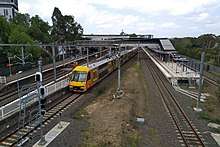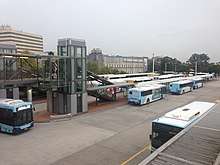Liverpool railway station, Sydney
Liverpool railway station is a heritage-listed railway station located on the Main South line, serving the Sydney suburb of Liverpool in Australia. It is served by Sydney Trains T2 Inner West & Leppington, T3 Bankstown and T5 Cumberland services. It was added to the New South Wales State Heritage Register on 2 April 1999.[2]
Liverpool | ||||||||||||||||||||
|---|---|---|---|---|---|---|---|---|---|---|---|---|---|---|---|---|---|---|---|---|
Station front in December 2007 | ||||||||||||||||||||
| Location | Bigge Street, Liverpool | |||||||||||||||||||
| Coordinates | 33°55′30″S 150°55′38″E | |||||||||||||||||||
| Owned by | Transport Asset Holding Entity | |||||||||||||||||||
| Operated by | Sydney Trains | |||||||||||||||||||
| Line(s) | Main South | |||||||||||||||||||
| Distance | 38.68 kilometres from Central | |||||||||||||||||||
| Platforms | 4 (2 side, 1 island) | |||||||||||||||||||
| Tracks | 5 | |||||||||||||||||||
| Connections | Bus | |||||||||||||||||||
| Construction | ||||||||||||||||||||
| Structure type | Ground | |||||||||||||||||||
| Disabled access | Yes | |||||||||||||||||||
| Other information | ||||||||||||||||||||
| Status | Staffed | |||||||||||||||||||
| Station code | LPO | |||||||||||||||||||
| Website | Transport for NSW | |||||||||||||||||||
| History | ||||||||||||||||||||
| Opened | 26 September 1856 | |||||||||||||||||||
| Electrified | Yes | |||||||||||||||||||
| Traffic | ||||||||||||||||||||
| Passengers (2018) | 19,820 (daily)[1] (Sydney Trains, NSW TrainLink) | |||||||||||||||||||
| Services | ||||||||||||||||||||
| ||||||||||||||||||||
History
The town (now suburb) of Liverpool on the Georges River was one of the earliest settlements of the colony of New South Wales. The station opened on 26 September 1856 and was an early terminus of the Main South line.[3] Immediately north of Liverpool station, a former branch line crossed the Georges River and entered the Holsworthy military base. The pylons for the bridge over the river have been reused to provide a pedestrian walkway.
In 1929, the line from Central was electrified. Liverpool remained the terminating point for electric services until the wires were extended to Campbelltown in 1968. It was also a calling point for regional services until the 1990s.
In 1965 one person was killed and three injured when a freight train collided with a stationary electric passenger train at Liverpool station.[4]
In 2000, the station underwent a major easy access upgrade with the provision of passenger lifts to the platforms, a new passenger concourse, toilets and a refurbishment of the heritage building on platform 1.[5]
The Southern Sydney Freight Line passes to the east of the station. It opened in January 2013. Around the same time, a new platform for southbound services was constructed as part of the Rail Clearways Program. Platform 4 opened in January 2014.[6][7] Previously platform 2 was the main southbound platform with platform 3 used for turnbacks.
Platforms and services

The station has four platforms. Platforms 1 and 4 serve the Inner West & Leppington and Cumberland lines, and platforms 2 and 3 serve as a terminus for Bankstown line trains.
| Platform | Line | Stopping pattern | Notes |
| 1 | services to Central & the City Circle via Granville | ||
|---|---|---|---|
| services to Schofields & Richmond | |||
| 2 | terminating services, returning to the City Circle via Bankstown | ||
| 3 | terminating services, returning to the City Circle via Bankstown | ||
| 4 | services to Leppington | ||
| services to Leppington |
Current Trackplan | ||||||||||||||||||||||||||||||||||||||||||||||||||||||||||||||||||||||||||||||||||||||||||||||||||||||||||||||||||||||||||||||||||||||||||||
|---|---|---|---|---|---|---|---|---|---|---|---|---|---|---|---|---|---|---|---|---|---|---|---|---|---|---|---|---|---|---|---|---|---|---|---|---|---|---|---|---|---|---|---|---|---|---|---|---|---|---|---|---|---|---|---|---|---|---|---|---|---|---|---|---|---|---|---|---|---|---|---|---|---|---|---|---|---|---|---|---|---|---|---|---|---|---|---|---|---|---|---|---|---|---|---|---|---|---|---|---|---|---|---|---|---|---|---|---|---|---|---|---|---|---|---|---|---|---|---|---|---|---|---|---|---|---|---|---|---|---|---|---|---|---|---|---|---|---|---|---|
| ||||||||||||||||||||||||||||||||||||||||||||||||||||||||||||||||||||||||||||||||||||||||||||||||||||||||||||||||||||||||||||||||||||||||||||
Trackplan prior to SSFL construction | ||||||||||||||||||||||||||||||||||||||||||||||||||||||||||||||||||||||||||||||||||||||||||||||||||||||||||||||||
|---|---|---|---|---|---|---|---|---|---|---|---|---|---|---|---|---|---|---|---|---|---|---|---|---|---|---|---|---|---|---|---|---|---|---|---|---|---|---|---|---|---|---|---|---|---|---|---|---|---|---|---|---|---|---|---|---|---|---|---|---|---|---|---|---|---|---|---|---|---|---|---|---|---|---|---|---|---|---|---|---|---|---|---|---|---|---|---|---|---|---|---|---|---|---|---|---|---|---|---|---|---|---|---|---|---|---|---|---|---|---|---|---|
|
| ||||||||||||||||||||||||||||||||||||||||||||||||||||||||||||||||||||||||||||||||||||||||||||||||||||||||||||||||
Transport links

Liverpool railway station has a busy bus station opened in 2000 attached to it.[5] Local bus services are operated by Interline,[8] Transdev NSW[9] and Transit Systems Sydney.[10]
It is also a calling point for some Greyhound Australia services to and from Canberra.[11]
Heritage listing
Liverpool railway station was listed on the New South Wales State Heritage Register on 2 April 1999. Although the station has been substantially altered, several heritage aspects remain, including the platform 1 station building, dating from c. 1880, the c. 1879 goods shed and 1880 brick-faced platforms.[2]
Liverpool station building is a good example of a third class station building in the centre of a large scale redevelopment of the site. It indicates the change in technology and approach to railway construction. Liverpool goods shed is a rare brick structure on the State system which is substantially intact with platforms and jib crane. It is located in an historic town and is the last remnant of the early station and yard complex at the site. It is rare as one of the last two surviving brick goods sheds in the State.[2]
References
- Transport Performance and Analytics (21 December 2018). "Train Station Entries and Exits 2016 to 2018". Train Station Entries and Exits Data. Open Data: Government of New South Wales. Retrieved 2 May 2020.
- "Liverpool Railway Station group". New South Wales State Heritage Register. Office of Environment and Heritage. H01181. Retrieved 2 June 2018.
- Liverpool Station NSWrail.net
- "Liverpool, NSW: Train Crash". Emergency Management Australia. Archived from the original on 21 October 2007. Retrieved 30 December 2006.CS1 maint: unfit url (link)
- "St Leonards and Liverpool Station Openings" Railway Digest April 2000 pages 10, 12
- Liverpool Fourth Platform Project Transport Infrastructure Development Corporation
- Liverpool Turnback Archived 8 January 2014 at the Wayback Machine Transport for New South Wales January 2014
- Interline Timetables Interline Bus Service
- Transdev Timetables Transdev NSW
- Transit System timetables Transit Systems
- Timetables Greyhound Australia
Attribution
![]()
External links

- Liverpool Public Transport Map Transport for NSW
- Liverpool station details Transport for New South Wales